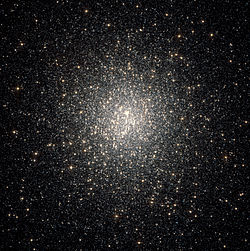蓋亞香腸
| 蓋亞香腸 或蓋亞-恩克拉多斯 或恩克拉多斯星系 | |
|---|---|
 藝術家對蓋亞-恩克拉多斯星系碎片的印象。黃色箭頭表示起源於矮星系的恆星位置和速度,這些數據來自於與銀河系的模擬合併,據信其性質與已經發生的合併相似。 | |
| 觀測資料 | |

蓋亞香腸或蓋亞-恩克拉多斯是大約80-110億年前與銀河系合併的矮星系(Sausage Galaxy、Gaia-Enceladus-Sausage、或Gaia-Sausage-Enceladus)的遺跡。銀河系中至少有8個球狀星團以及500億太陽質量的恆星、氣體和暗物質來自這個矮星系[1]。它代表著銀河系最後一次重大的合併[2]。
詞源
[編輯]其所以被稱為蓋亞香腸,是因為在速度空間圖中,成員分布的特徵像香腸的形狀,特別是使用蓋亞任務的數據繪製的徑向()與恆星(見球面坐標系)的方位角速度()的曲線圖[1]。與銀河系合併的恆星有高度細長的軌道。它們軌道的最外側點距離銀河系中心約20,000秒差距,這就是所謂的"暈斷裂"[3]。這些恆星以前在依巴谷數據中見過[4],並被確認為起源於一個吸積星系[5]。
"恩克拉多斯"這個名字是指神話中的巨人恩克拉多斯,他被埋葬在埃特納火山下,並引發了地震。因此,這個前星系被掩埋在銀河系中,並導致膨脹的厚圓盤[2]。
成員
[編輯]球狀星團
[編輯]確定為前蓋亞香腸成員的球狀星團有M2、M56、M75、M79、NGC 1851、NGC 2298、NGC 5286[1]。
NGC 2808: 球狀星團還是舊核心?
[編輯]
NGC 2808是蓋亞香腸類似球狀星團的成員。這個星團的成員全部都是在星團形成後2億年內誕生的三代恆星組成[6]。
解釋三代恆星的一種理論是NGC 2808是蓋亞香腸的前核心[1]。這也可以解釋超過一百萬顆恆星的異常,因為對於球狀星團來說,這樣的恆星數量是異常大的。
恆星
[編輯]來自這個矮星系的恆星圍繞銀河系核心運行,其極端的離心率約為0.9。它們的金屬量通常也比其它暈星高,大多數恆星的[Fe/H]>為 -1.7dex,即至少為太陽值的2%[3][7]。
"蓋亞香腸"重建了銀河系,它帶入銀河系的氣體觸發了新一輪的恆星誕生,補充了銀河盤面的恆星,使薄盤膨脹成為厚盤。來自矮星系的碎片提供了銀暈中大部分富含金屬的部分[1]。
相關條目
[編輯]- 流場
- 麒麟座環
- 半人馬座ω
- M32p:合併進仙女座星系的大星系,為仙女座提供了厚的星系盤和許多的星系暈星。
- J1124+4535
參考資料
[編輯]- ^ 1.0 1.1 1.2 1.3 1.4 Myeong, G.C.; Evans, N.W.; Belokurov, V.; Sanders, J.L.; Koposov, S. The Sausage globular clusters. The Astrophysical Journal. 2018, 863 (2): L28. Bibcode:2018ApJ...863L..28M. S2CID 67791285. arXiv:1805.00453
 . doi:10.3847/2041-8213/aad7f7.
. doi:10.3847/2041-8213/aad7f7.
- ^ 2.0 2.1 Galactic Ghosts: Gaia Uncovers Major Event in the Formation of the Milky Way Galaxy. Gaia. ESA. 31 October 2018 [2022-06-08]. (原始內容存檔於2022-03-14).
- ^ 3.0 3.1 Deason, Alis; Belokurov, Vasily; Koposov, Sergey; Lancaster, Lachlan. Apocenter Pile-Up: Origin of the stellar halo density break. The Astrophysical Journal. 2018, 862 (1): L1. Bibcode:2018ApJ...862L...1D. S2CID 118936735. arXiv:1805.10288
 . doi:10.3847/2041-8213/aad0ee.
. doi:10.3847/2041-8213/aad0ee.
- ^ Chiba, Masashi; Beers, Timothy C. Kinematics of Metal-poor Stars in the Galaxy. III. Formation of the Stellar Halo and Thick Disk as Revealed from a Large Sample of Nonkinematically Selected Stars. The Astronomical Journal. June 2000, 119 (6): 2843–2865. Bibcode:2000AJ....119.2843C. S2CID 16620828. arXiv:astro-ph/0003087
 . doi:10.1086/301409.
. doi:10.1086/301409.
- ^ Brook, Chris B.; Kawata, Daisuke; Gibson, Brad K.; Flynn, Chris. Galactic Halo Stars in Phase Space: A Hint of Satellite Accretion?. The Astrophysical Journal. 10 March 2003, 585 (2): L125–L129. Bibcode:2003ApJ...585L.125B. S2CID 16936195. arXiv:astro-ph/0301596
 . doi:10.1086/374306.
. doi:10.1086/374306.
- ^ Piotto, G.; et al. A Triple Main Sequence in the Globular Cluster NGC 2808. The Astrophysical Journal. May 2007, 661 (1): L53–L56. Bibcode:2007ApJ...661L..53P. S2CID 119376556. arXiv:astro-ph/0703767
 . doi:10.1086/518503.
. doi:10.1086/518503.
- ^ Iorio, Giuliano; Belokurov, Vasily. Chemo-kinematcs of the Gaia RR Lyrae: the halo and the disc. Monthly Notices of the Royal Astronomical Society. 2021, 502 (4): 5686–5710. Bibcode:2021MNRAS.502.5686I. doi:10.1093/mnras/stab005.
進階讀物
[編輯]- Belokurov, V.; Erkal, D.; Evans, N.W.; Koposov, S.E.; Deason, A.J. Co-formation of the disc and the stellar halo. Monthly Notices of the Royal Astronomical Society. July 2018, 478 (1): 611–619. Bibcode:2018MNRAS.478..611B. arXiv:1802.03414
 . doi:10.1093/mnras/sty982.
. doi:10.1093/mnras/sty982. - Myeong, G.C.; Evans, N.W.; Belokurov, V.; Sanders, J.L.; Koposov, S.E. The Milky Way halo in action space. The Astrophysical Journal Letters. April 2018, 856 (2): L26. Bibcode:2018ApJ...856L..26M. S2CID 73518200. arXiv:1802.03351
 . doi:10.3847/2041-8213/aab613.
. doi:10.3847/2041-8213/aab613. - Myeong, G.C.; Evans, N.W.; Belokurov, V.; Sanders, J.L.; Koposov, S.E. The Shards of ω Centauri. April 2018. arXiv:1804.07050
 [astro-ph.GA].
[astro-ph.GA]. - Chaplin, William J.; Serenelli, Aldo M.; Miglio, Andrea; Morel, Thierry; Mackereth, J. Ted; Vincenzo, Fiorenzo; Kjeldsen, Hans; Basu, Sarbani; Ball, Warrick H.; Stokholm, Amalie; Verma, Kuldeep. Age dating of an early Milky Way merger via asteroseismology of the naked-eye star ν Indi. Nature Astronomy. Jan 13, 2020, 4 (4): 382–389 [2022-06-08]. Bibcode:2020NatAs...4..382C. ISSN 2397-3366. S2CID 210166431. arXiv:2001.04653
 . doi:10.1038/s41550-019-0975-9. hdl:1721.1/128912. (原始內容存檔於2022-03-21) (英語).
. doi:10.1038/s41550-019-0975-9. hdl:1721.1/128912. (原始內容存檔於2022-03-21) (英語).
外部連結
[編輯]- YouTube上的Gaia Sausage Simulation YouTube
- Jocelyn Duffy. The Gaia Sausage: The major collision that changed the Milky Way galaxy. Carnegie Mellon University. 4 July 2018 [2019-12-06]. (原始內容存檔於2020-08-21).
- Sarah Collins. The Gaia Sausage: The major collision that changed the Milky Way. University of Cambridge. 4 July 2018 [2019-12-06]. (原始內容存檔於2021-03-09).



